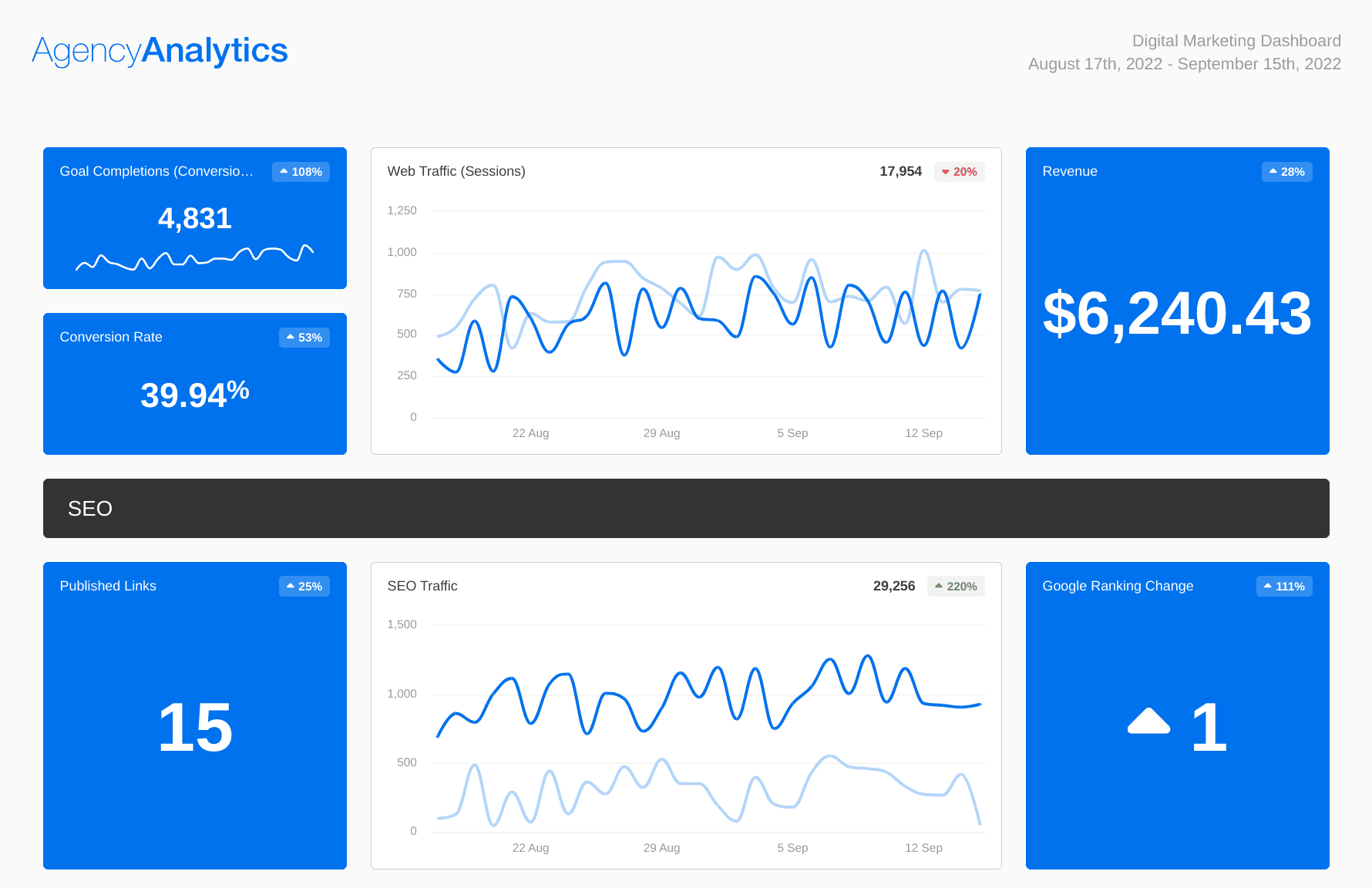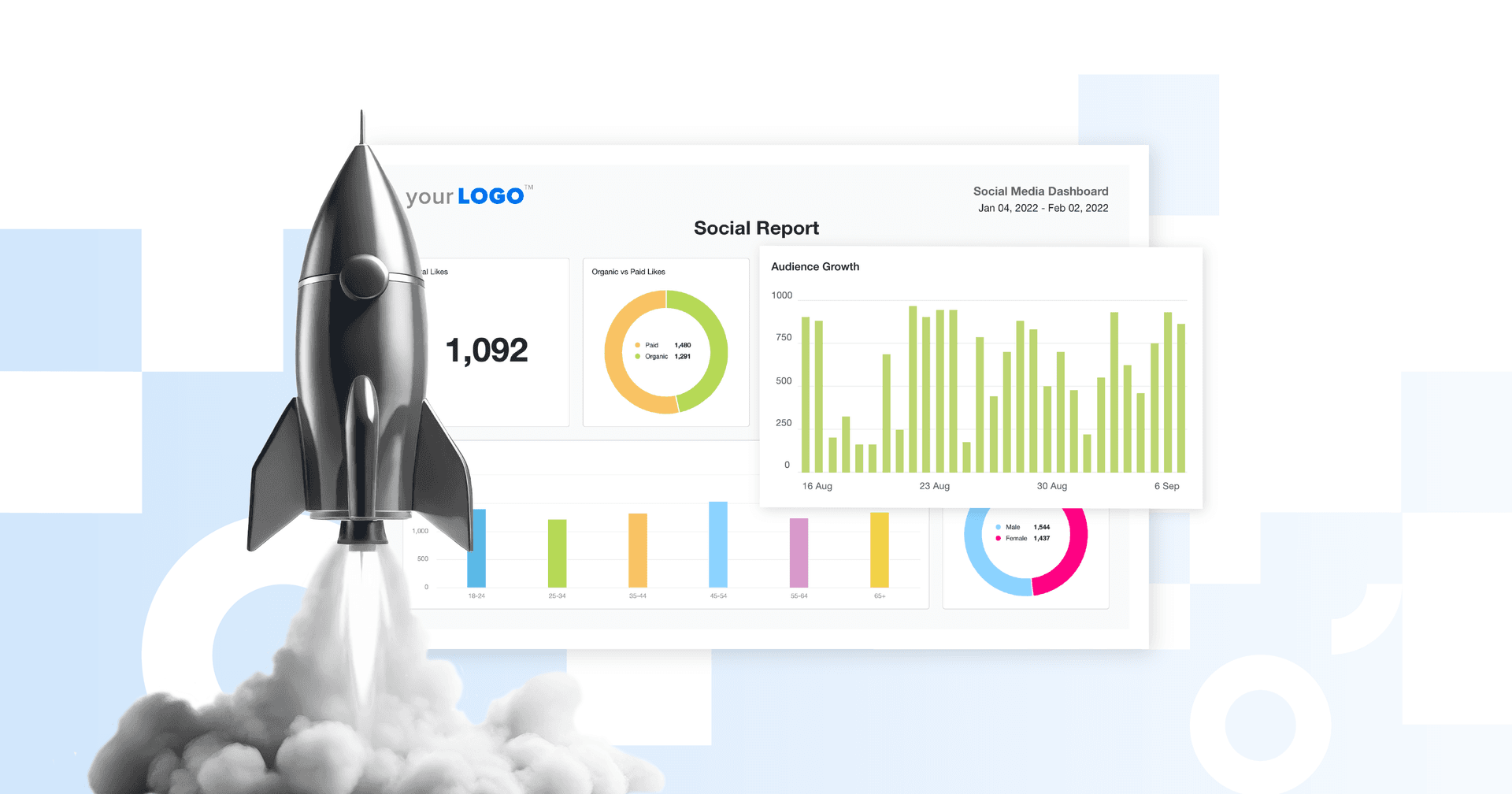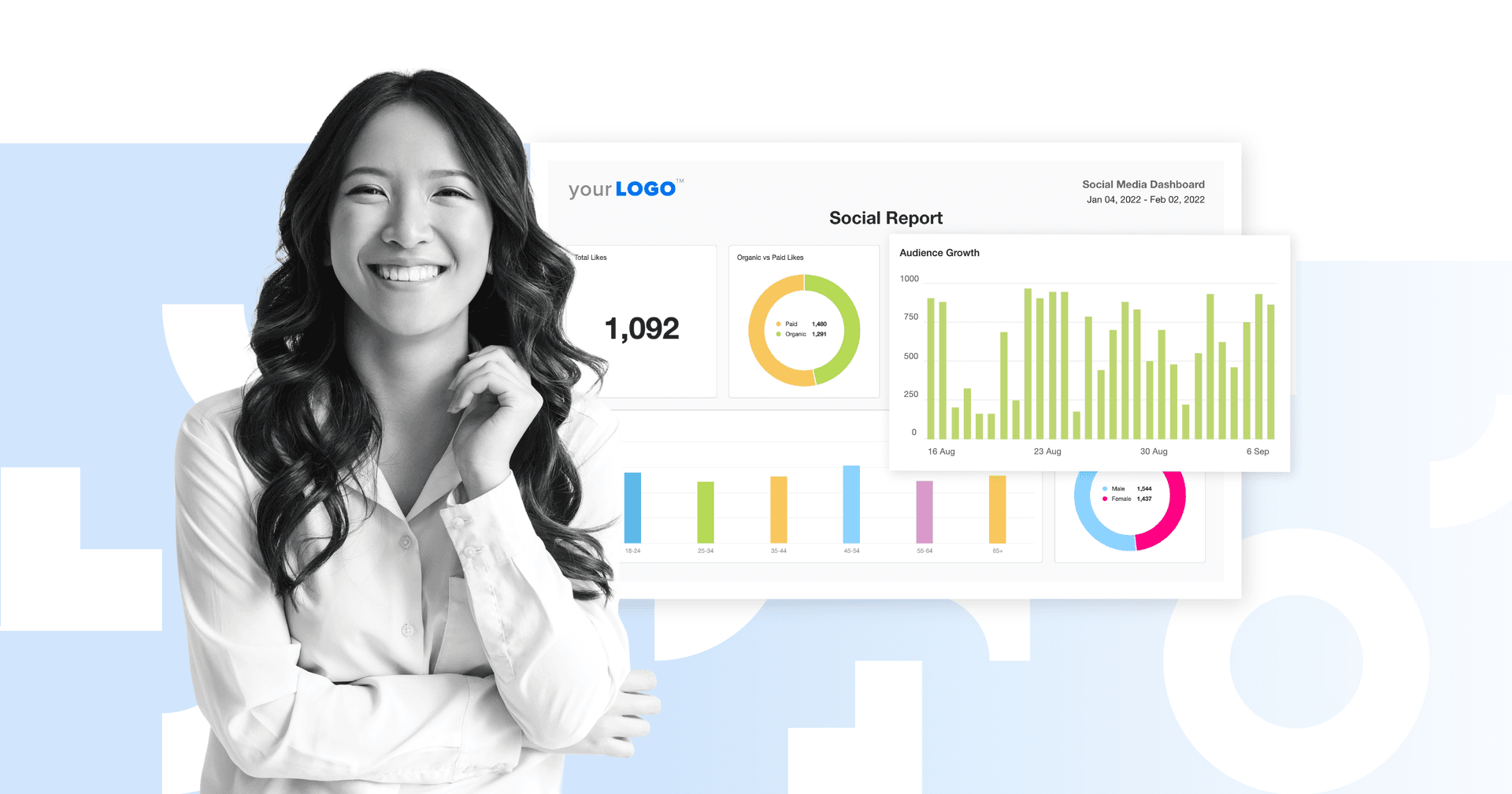Table of Contents
Table of Contents
- What Is Earned Media?
- Why Is Earned Media Important?
- Why Is It Harder to Measure Earned Media Versus Paid Media?
- Metrics for Measuring EMV
- How Do You Calculate Earned Media Value?
- How to Report Earned Media Value
- The Benefits of Reporting Earned Media Value
- How To Create an EMV Report
- Summary and Key Takeaways
7,000+ agencies have ditched manual reports. You can too.
Free 14-Day TrialQUICK SUMMARY:
Earned media analytics provide marketing agencies with insights into the performance and impact of their non-paid media efforts. An earned media report analyzes data from sources like social media mentions, online reviews, and organic press coverage, offering a comprehensive view of brand reputation, audience engagement, and the effectiveness of PR and content strategies in generating organic reach and credibility. Although it is harder to measure earned media than it is for paid or owned media, there are ways to report earned media value to your clients and showcase results.
As a marketer, you know the essential value of earned media. But you also know that it's harder to measure than paid media. Despite that, earned media can be extremely effective in terms of illustrating the ROI of some of the harder-to-measure marketing efforts, such as social media and brand mentions.
Earned Media Value is defined as the equivalent dollar value of exposure gained through non-paid channels, such as social media mentions, reviews, and organic search results.
Even though earned media campaigns may not immediately generate an increase in leads and revenue, they're still an essential part of business growth. The goal of any marketing campaign should be to increase brand awareness and create a positive impression of a company. If you can achieve that, you're well on your way to long-term success.
And it's important for clients to understand that success and how it aligns with their unique business goals. “No two client are alike. Some clients want to see rankings, others want to see page views, and others want to see the number of calls from Google My Business,” says Ruben Roel, President of Investigator Marketing. “Report on what your client wants to see, not what you sell,” he suggests. “We sell SEO and PPC Services. Our clients don't care about how they work. They care about calls and their bottom line.”
So, how do you report that value to your clients? It's not always easy, but there are ways to do it.
In this blog post, we'll walk you through the process of reporting earned media value to your clients. We'll also show you some tools and resources to help make the process easier.
What Is Earned Media?
Before we get into reporting earned media value, let's first define what earned media is. Earned media is any publicity or placement you didn't have to pay for. It can come in social media mentions, news articles, organic traction on blog posts, referral traffic from other sites, or even word-of-mouth buzz. Earned media is any time a brand gets mentioned in a positive light, or a visitor comes to a website without having to spend money to drive the click.
This is different from traditional media spend because it's not something that you can directly control. With earned media, you're relying on other people–or algorithms–to reflect your client's brand in a positive way. This can be tricky, but it also makes earned media valuable. When done right, earned media can help build trust and credibility for your client’s brand. It can also reach a broad audience quickly and at a fraction of the cost of paid media.
Why Is Earned Media Important?
As we touched on briefly above, earned media is important because it helps build trust and credibility for your client’s brand. (It's also a part of the PESO Model™, a guiding framework for marketing agencies). Customers who see that a brand is getting positive press coverage or social mentions are more likely to trust that brand and feel good about doing business with it. The same applies to organic search. Ranking well on Google, being featured in snippets or a knowledge panel, and having positive reviews shown on Google can help build brand trust. And when customers trust the brand, the chances of them spending money with them increase.
Let's imagine the following two scenarios:
Scenario One: You're on a company website where they talk about how excellent their own products are and how they have the best customer service.
Scenario Two: You're reading your favorite blog or browsing one of the social media profiles you follow, and that author has just posted something about how great a particular company's products are and how they have fantastic customer service.
Who are you more likely to believe?
Not only does earned media provide a source of traffic without the constant drain of campaign spend, it often imparts a higher authority and trustworthiness to a brand. Although brand trust is much more challenging to put a number against, there are ways to help quantify the dollar value of these earned media campaigns. And setting numbers to a metric enables clients to quantify the value of their investment.
Probably the most common theme of what has upset clients in the past is reporting on positive-looking metrics that seem to indicate we're making good progress, e.g., rapid ranking increases of keywords with zero search volume, when from the client's point of view, they're getting zero return on investment because those increases aren't driving the results they wanted to see. - Daniel Noakes Founder UClimb
By calculating an earned media value, you assign a specific value to the actual results being driven, not vanity metrics such as the number of followers or the number of ranking keywords.
Why Is It Harder to Measure Earned Media Versus Paid Media?
Measuring earned media can be tricky because many variables are involved. For example, let's say your client gets a mention in a blog post. It's impossible to know how many people read that blog post and saw their mention. And even if your agency could track that number, it would be hard to know how much impact that mention had on influencing the client’s potential customers.
With paid media, on the other hand, you have more control over the variables. You can track how many people see your ad and click on it. You can also track how many sales or leads you generate from that ad. This makes it easier to calculate ROI for paid media campaigns and, in turn, makes it easier to report that data to clients.
However–using the right web analytics tools–there are elements of earned media to track, which include:
Referral Traffic
Brand Mentions
Inbound Links
Organic Traffic
And while you may not be able to track every single person who saw your client’s earned media mention, when you create an SEO dashboard, you still get a general idea of the reach and impact it had on your client's overall marketing mix.
Metrics for Measuring EMV
The metrics used for measuring EMV can vary depending on the client and what they are looking for. However, key performance indicators include reach, social media traffic, web traffic data, brand mentions, sales team feedback, and calculated value metrics.
Let’s take the example of Expand Agency. Ads Specialist, Kim Messenheimer, talks about a time when they had a client who wanted their brand top of mind.
“With just brand awareness campaigns running, our focus for that client shifted purely to engagement metrics,” she says. With this type of focus, where exposure and engagement metrics “were not only included in our reports but it was the main focal point.” Assigning an earned media value helps reinforce the contribution being driven by the agency.
But the other, potentially more important, aspect is that it shines a light on the value of an otherwise softer digital marketing metric.
Yes, it's nice to report on the number of views a social post had or the number of clicks that came in on that new blog post, but assigning a value-based metric makes the number that much easier to understand and appreciate for clients.
How Do You Calculate Earned Media Value?
One of the challenges with earned media is that it is difficult to quantify the value in a way that makes sense to clients. How much is that social media impression or that organic visit worth, and how would you reflect that to clients in a Social Media or SEO dashboard?
There are various ways to calculate earned media value, many of which attempt to consider the impact on brand awareness and perceived value, brand sentiment, the share of voice, and engagement. But sometimes, that can be a bit too fuzzy for clients.
Instead, one of the best (and possibly easiest) ways for a marketing agency is to calculate the value of earned media by comparing it to the cost of a paid media campaign, either from a CPC or a CPM standpoint.
By doing so, your agency sets a dollar value to the hard-won impressions and clicks that were earned, not paid for.
Michael Gasser, Co-owner of Squeeze Marketing uses a data-driven marketing strategy to showcase the value his agency brings. He says reporting on earned media value puts a monetary value on the work they do for their client's social media management services.
“You have to add up the impressions and the clicks and then take that client’s cost per click and CPM on that platform to make sure you’re accurate,” Gasser explains.
Squeeze does this with the Google Sheets integration combined with data from Facebook to create their specific earned media value formulas.
“There’s a block in our AgencyAnalytics reports that spits out earned media value. It allows us to bring in new statistics every month that are highly valuable to the client and it also helps show the client the value of our services,” says Gasser.
Here are some common ways to calculate an earned media value:
Cost Per Thousand Impressions
When you have access to the impression data, such as through social media analytics, it's easy to calculate a comparable CPM value for earned media by creating a social media dashboard for your clients.
When it comes to paid advertising, many will agree that influencer marketing can have one of the highest ROIs out there. And your agency easily shows this value with influencer marketing analytics.
But for example’s sake, let’s say an influencer’s organic social media post generated 20,000 impressions, and you typically pay a CPM of $20 to advertise on Instagram, then those impressions are worth $400 in exposure.
Multiply that by three posts per week across three social media platforms and that organic value adds up pretty quickly.
Cost Per Click
Another way to convert earned media into a value-based metric is by looking at the clicks driven by each earned channel. For example, if your content marketing strategy is driving 2,000 visitors a day to a client's website, and the average CPC for Google Ads is $2.00, it could be fair to say those visitors are worth up to $4,000 in clicks that would otherwise have to be paid for.
Adding an Earned Media Adjustment Variable
The one thing your agency needs to keep in mind is that not all clicks are created equal. Typically, organic search converts at a lower rate than paid search, and social media–although great for awareness and engagement–often has a much lower conversion rate than paid search.

Therefore, it wouldn't be reasonable to take all of the clicks driven by social media and simply multiply that by the average Google Ads PPC. That wouldn’t be a fair comparison, let alone be equal. You'd want to use a multiplier to set a reasonably equivalent estimated click value.
Going back to the social media example from earlier, if that organic social post generated 200 clicks, and you typically have to pay a CPC of $6 on Google Ads, where the conversion rate is 3x that of social media, you could estimate that those clicks are worth $400 using the following formula:
200 x ($6.00/3) = $400
Even with an adjustment value, earned media still drives a significant and real volume of cost-effective clicks for clients, so it's important to highlight that value and not take it for granted.
How to Report Earned Media Value
Now that we've answered the questions "What is earned media?” and “Why should you care?", let's move on to reporting earned media value to your clients. Here are a few tips:
Use social listening tools: Social listening tools like Hootsuite Insights or BuzzSumo can help you track and measure earned media impressions. These tools will show how many people are talking about your client's brand, what they're talking about, and what they're saying. This information can be extremely valuable when trying to quantify the value of earned media for a business.
Look at web traffic data: A website's analytics can also give insights into the value of earned media clicks. Look at referral traffic, organic search traffic, and social media traffic. If you see spikes in any of these areas after a piece of earned media is published, that's a good sign that the earned media positively impacts your client’s business.
Talk to the sales team: Another great way to measure the value of earned media is to talk to the sales team. They should be able to tell you if they've seen an increase in sales or inquiries since a particular piece of earned media was published. This information can be extremely valuable when trying to quantify the value of earned media for your client’s business.
Create a custom metric: One easy way to report on earned media is to create a custom metric that calculates the estimated dollar value of earned media by multiplying the earned clicks by a set dollar figure, such as the equivalent cost your agency would have paid to drive that click through paid search. To calculate the dollar value, you can either use the average Google Ads CPC or an adjusted average that takes into account the conversion rate difference between paid traffic and earned traffic.
A great place to start is by looking for these organic metrics on Facebook or Google Analytics. Here’s an example of something you could set up as a Google Sheets formula to calculate your own specific custom metrics for your clients:
(Organic Traffic * Google Ads Average CPC/1.35) + (Social Media Traffic * Google Average CPC/3) + (Referral Traffic * GoogleAverage CPCx1.8) = Total Earned Media Value by Clicks
Once this metric is ready, use the Google Sheets integration or custom metrics to automatically add Earned Media value to your custom client reports.
Agency Tip: Save hours each month by streamlining your reporting with an earned media report template—customizable and ready to impress your clients.
The Benefits of Reporting Earned Media Value
Reporting earned media value benefits your agency and your clients. Not only does it help you track the impact of your earned media efforts, but also it can help justify earned media budgets to clients or upper management.
Although most clients care about the direct correlation between earned media and either the leads or sales it generates, setting an earned media value estimate as a leading indicator is a great way to show off how much that traffic would have cost if it had been generated through paid channels.
Whether or not you include an earned media value widget in your client reports is something your team should discuss directly with your client. It’s always important to align your reports with the social media or SEO metrics the client needs in order to understand your agency’s performance.
“At our agency, we believe that metrics are only useful if they help to drive decision-making,” says Guy Hudson, Founder of Bespoke Marketing Plans. “As a result, we focus on identifying actionable metrics that can be used to inform and improve our marketing efforts. To do this, we start by taking a close look at our goals and objectives. We then identify the key performance indicators (KPIs) that will help us measure progress towards those goals. Once we have a clear understanding of our KPIs, we can choose the metrics that will provide the most insights into our performance. By taking this approach, we ensure that our metrics are always actionable and informative.”
How To Create an EMV Report
Now that we've gone over some of the benefits of reporting earned media value let's look at how you can create an EMV report. Here are a few tips:
Start with a template: We recommend starting with the AgencyAnalytics digital marketing dashboard template or digital marketing monthly report template. This way, you can include the earned media value alongside the other digital marketing analytics you need to provide to a given client.

Include all relevant information: Be sure to include everything your client or boss will need to see to understand the value of your earned media efforts. This should consist of reach, social media traffic, web traffic data, sales team feedback, custom metrics, and data that is automatically pulled in from Google Sheets.
Make it visually appealing: Remember, people are more likely to pay attention to something if it's visually appealing. So, be sure to make your EMV report easy on the eyes. Data storytelling is a great way to help your clients comprehend the metrics in front of them.
Simplify data presentation: Align your metrics with your clients' interests and consistently impress them with your success story. Starting with a pre-designed marketing report template makes it easier to turn data into narratives that resonate.
By following these tips, you create an EMV report that effectively communicates the value of your earned media efforts.
Summary and Key Takeaways
Reporting on earned media value greatly benefits agencies and their clients. By tracking the impact of earned media on things like impressions and traffic, even before they become leads or sales, it becomes easier to justify the marketing budget for these campaigns. Additionally, making an EMV report that is visually appealing makes it more likely that clients will pay attention to it.
Some key takeaways from this post include:
Create a custom metric to calculate the estimated dollar value of earned media.
Use the source's current conversion rate data to set the appropriate adjustments against a set CPC baseline, such as Google Ads.
Include all relevant information in your EMV reports, such as reach, social media traffic, and web traffic data.
Add sales team feedback, which can automatically be imported through a Google Sheets integration.
Make your EMV report visually appealing for clients to understand easily.
We hope these tips will help you calculate EMV and create a report that effectively communicates the value of your earned media efforts!
Creating custom earned media value reports is easy with AgencyAnalytics. Check it out for yourself with the 14-day free trial.
Client Reporting Made Easy with Customizable Report Templates
Multi-Channel Report Templates | Platform-Specific Report Templates |

Written by
Richelle Peace is a writer with a degree in Journalism who focuses on web content, blog posts, and social media. She enjoys learning about different topics and sharing that knowledge with others. When she isn’t writing, Richelle spends time teaching yoga, where she combines mindfulness, movement, and her passion for wellness.
Read more posts by Richelle PeaceSee how 7,000+ marketing agencies help clients win
Free 14-day trial. No credit card required.






